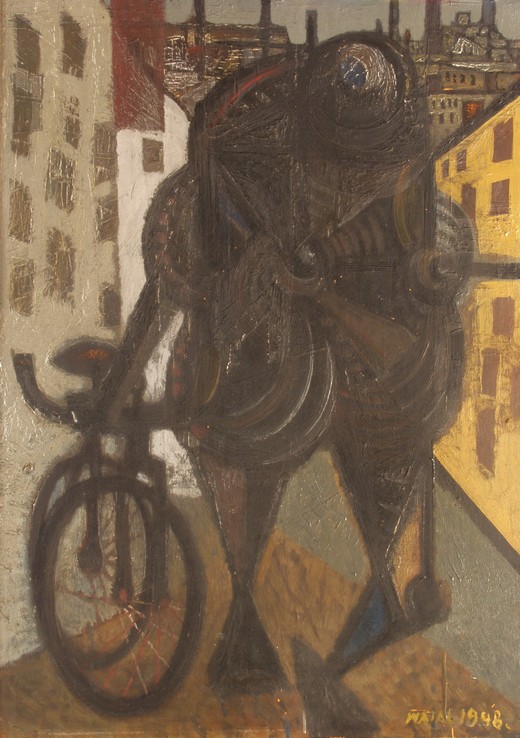oil, cardboard, 68.5 x 48.5 cm
Matal was born on January 13, 1922 in Brno, where he also graduated from the School of Arts and Crafts with prof. E. Hrbek and F. V. Süsser. In October 1941 he was deported to labor camps in Lohbrück near Breslau and later to Oswitz, where he worked in a chain factory. Immediately after returning from internment, he threw himself fully into the center of art. In 1945 he gradually became a member of Umělecká beseda, the Association of Fine Artists Aleš, the Bloc of Fine Artists of the Moravian-Silesian Country and the already mentioned Group 42. In 1946 he participated in the exhibition of the most important young artists of Czechoslovakia "Art Tchécoslovaque 1938-1946" at the La Boëtie Gallery in Paris. The very next year, the painter had a solo exhibition organized by SVU Aleš in the Brno House of Art. After 1948, political developments in what was then Czechoslovakia had a severe impact on artists with strong moral principles, belief in humanitarian ideals, and freedom, and greatly complicated his creative work. Bohumír Matal could not exhibit for many years, he closed himself in his studio and continued to work tirelessly in the spirit of Group 42. Later he managed to group a group of friends around his studio in Brno on Česká street, from which the creative group Brno 57 emerged in 1957. he left Brno for the countryside, to Prudká u Doubravníku, where he bought an old derelict mill, which he gradually repaired and rebuilt into a studio. He also died here after a long illness on July 7, 1988.
His work was initially influenced by surrealism, then he focused on a dreamy-colored civilization, in the spirit of the theme of Group 42 he dealt with the relationship between man and modern technology and civilization. Gradually, however, he worked his way up to abstract painting influenced by Cubism. In the 1960s, lyrical abstraction and experimentation appeared in Bohumír Matal's work; in addition to painting, in the following years he also devoted himself to scenography, graphics (ex libris) and monumental realizations in architecture.
The work of Bohumír Matal is characterized by work in free cycles, he returned to one subject until he was convinced of his exhaustion. In the second half of the 1940s, this main theme is "Man in the city, the city in man", which he elaborated in more than ten variants. Jihlava painting The figure with a bicycle from 1948 is one of the last works of this cycle. In the foreground of the sharp perspective vanishing point of the tenement-lined street stands a monstrous figure formed by a vortex of semicircles and triangles holding a bicycle on the left side. The phantasmagoric figure contrasts with the sensory fidelity of the city street and evokes a mysterious fear and a sense of danger. Dark gray-brown color predominates here.

phone number: 567 217 133; 605 221 763
bojanovska@ogv.cz



